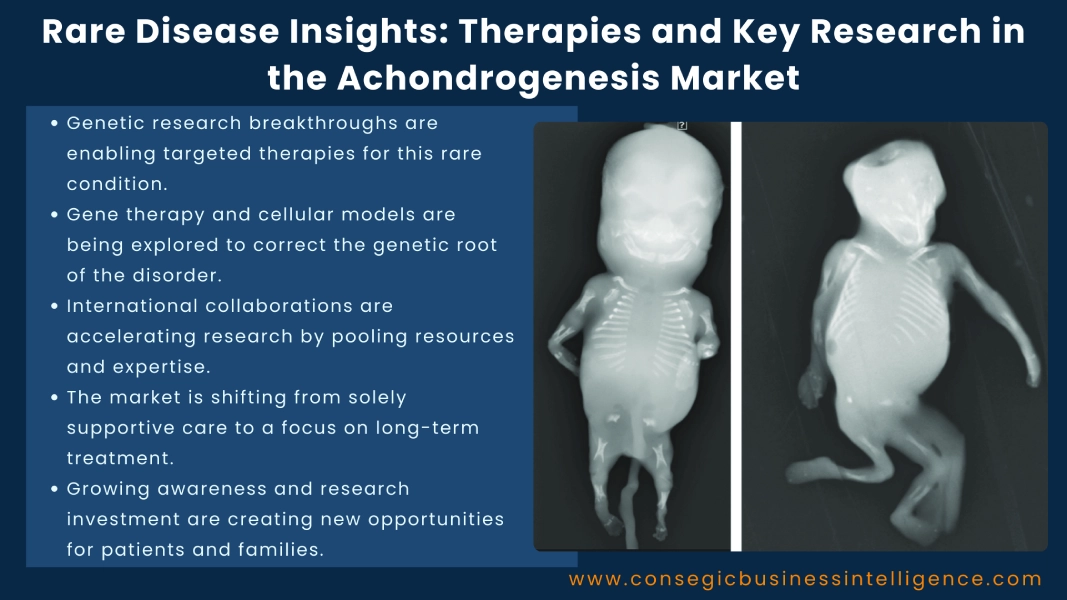Rare Disease Insights: Therapies and Key Research in the Achondrogenesis Market
Achondrogenesis is an extremely rare genetic condition that affects the development of bones and cartilage. Babies born with this disorder have very short limbs, small chests, and underdeveloped lungs, which often makes survival beyond the newborn stage very difficult. Because of its severity and rarity, treatment options today are limited and mostly focus on providing comfort and supportive care.

At the same time, major advances in genetics, cell biology, and molecular research are creating new possibilities. Further, researchers are beginning to explore innovative therapies that could one day change the outlook for patients and families. By combining supportive treatments with breakthroughs in gene therapy, stem cell models, and international collaborations, the achondrogenesis market is slowly moving toward a future with more hope.
In this blog, we’ll explore prominent therapies currently applied in achondrogenesis care and key research areas driving innovation in this rare disease market.
Therapies in the Achondrogenesis Market
- Prenatal Genetic Testing and Counseling
Genetic testing through exome sequencing or targeted panels allows precise identification of mutations such as TRIP11, SLC26A2, or COL2A1. Once confirmed, families receive counseling on prognosis and delivery planning. Early testing helps guide informed decision-making, improves perinatal care strategies, and opens pathways to participation in registries or clinical studies.
- Neonatal Intensive Care and Respiratory Support
Infants born with achondrogenesis often face immediate respiratory distress due to underdeveloped lungs. Neonatal intensive care units provide oxygen therapy, mechanical ventilation, and nutritional stabilization. While survival remains limited, supportive care ensures comfort and gives families valuable time for bonding and further medical evaluation.
- Palliative and Family-Centered Care
Given the high mortality rate, palliative care frameworks are central to management. These approaches focus on comfort, pain management, and emotional support for families. Clear discussions between medical teams and families help guide decisions about resuscitation and intervention intensity, ensuring care aligns with family goals.
- Symptom-Based Orthopedic and Surgical Interventions
In the rare cases where survival extends beyond the perinatal period, surgical or orthopedic interventions may address fractures, spinal issues, or joint complications. Although options are limited, these therapies provide symptom relief and improve quality of life, highlighting the importance of multidisciplinary care teams.
- Enrollment in Rare Disease Registries and Natural History Programs
While not a treatment in the traditional sense, participation in disease registries ensures patients and families access specialized support and clinical monitoring. These registries provide valuable data for researchers, help track disease progression, and build the foundation for future clinical trials.
Key Research Areas Driving the Achondrogenesis Market
- Gene Therapy Approaches
Researchers are investigating the potential of gene replacement therapies for achondrogenesis, particularly for mutations in TRIP11, COL2A1, and SLC26A2. Preclinical work explores vectors capable of delivering functional genes to developing skeletal tissues, although significant challenges around timing and safety remain.
- CRISPR and Precision Gene Editing
Gene editing technologies such as CRISPR/Cas9 are being studied in laboratory models to correct disease-causing mutations at the DNA level. Patient-derived iPSCs (induced pluripotent stem cells) are being used to test the feasibility of repairing faulty genes. While clinical use is still far off, this research could eventually transform treatment for achondrogenesis.
- iPSC and Stem Cell Models for Drug Screening
iPSC technology enables researchers to replicate patient-specific chondrocytes and skeletal tissues in the lab. These models help study disease mechanisms and screen for small molecules or biologics that might improve bone growth. This approach provides a scalable platform for identifying candidate therapies tailored to specific genetic subtypes.
- Small Molecules and Chaperone Therapy
For certain mutations, misfolded proteins impair cellular function. Researchers are exploring pharmacological chaperones and small molecules that improve protein folding, trafficking, or sulfate transport. These compounds may not cure the disease but could reduce severity, offering a more accessible therapeutic route than gene therapy.
- International Registries and Natural History Studies
One of the most impactful areas of research is the development of global databases that track genetic, clinical, and survival outcomes. These registries provide researchers with the data needed to design trials, identify biomarkers, and establish measurable endpoints. Such infrastructure is crucial to accelerating drug development for ultra-rare diseases like achondrogenesis.
Conclusion
The achondrogenesis market is defined by its rarity, severity, and limited treatment options. Current therapies focus on prenatal genetic diagnosis, neonatal support, palliative care, and symptom-based interventions, while registries provide long-term value for patients and researchers alike. At the same time, cutting-edge research in gene therapy, CRISPR editing, iPSC modeling, and small-molecule therapies is laying the groundwork for future breakthroughs. With greater global collaboration and sustained investment, the long-term outlook for achondrogenesis could shift from purely supportive care to meaningful disease-modifying interventions.
